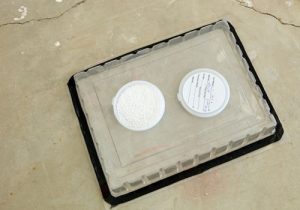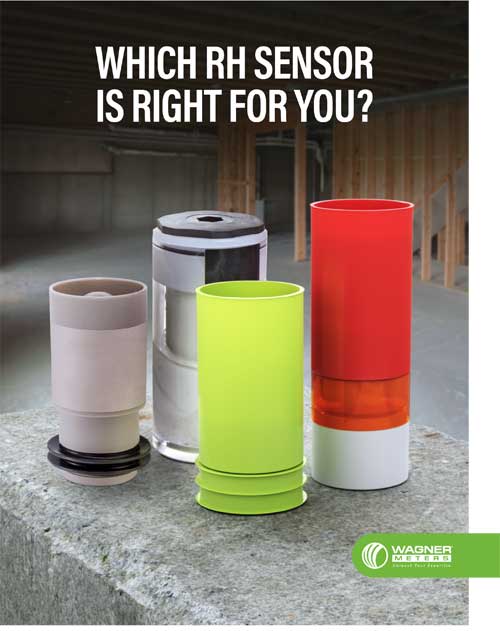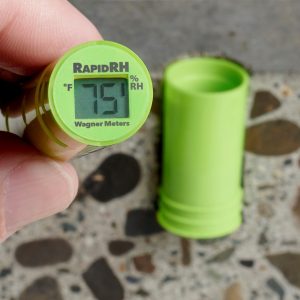Calcium Chloride Moisture Test vs. Relative Humidity
Concrete moisture testing methods, like calcium chloride (MVER) or the concrete moisture meter, test the surface of the slab.
But they fail to take into account an important aspect of concrete drying: the moisture gradient, or moisture differential, as it’s called in the American Concrete Institute’s Guide for Concrete Slabs that Receive Moisture-Sensitive Flooring (ACI 302.2).
We’re going to explore the Calcium Chloride Moisture Test versus Relative Humidity Testing and discover how these methods can help prevent costly flooring failures due to excess moisture.
Let’s dive into the world of concrete moisture testing and ensure a solid foundation for your next flooring project.
- How Do You Know How Much Moisture Will Come Up Once You Install that Floor Covering?
- How Do You Know What that Future Equilibrium Moisture Level Will Be?
- Accurate Moisture Testing for Concrete
- Best Concrete Moisture Test
As concrete slabs dry, they tend to have less moisture on the surface and more moisture deep within. When a floor covering is applied on top, the moisture deep within rises to the surface and remains there since evaporation can’t happen quite as easily.
How Do You Know How Much Moisture Will Come Up Once You Install that Floor Covering?
It’s about understanding the term equivalent depth.
Research at the Technical University of Lund shows that “the moisture level at a certain ‘equivalent depth’ from the surface is exactly equal to the moisture level which will be achieved at the surface after the floor covering is laid.” (Hedenblad, “Drying of Construction Water in Concrete, 1997, p. 11–12).
That depth for a slab drying from one side is 40% (Ibid.).
That’s why ASTM F2170, the standard for relative humidity (RH) testing, requires drilling into the slab at 40% depth and placing probes there. This method will give you the most accurate picture of the slab’s future moisture condition—and confidence for a successful floor installation.
Moisture is a major cause of flooring failure. It can lead to the breakdown of floor covering adhesives, warping, or even mold growth (ACI 302.2).
But where is this moisture coming from?
Often from the subfloor, particularly a concrete one.
The American Concrete Institute’s Guide for Concrete Slabs that Receive Moisture-Sensitive Flooring states, “As the slab dries, the concrete loses more moisture from the top than from the middle or bottom” (ACI 302.2).
This creates a moisture gradient within the slab. There is less moisture on the slab’s surface and more deep within.
However, the moisture deep within eventually rises to the surface when a floor covering is applied on top.
In Concrete Floors and Moisture, a book written on behalf of the Portland Cement Association (find it on their website), author Howard Kanare discusses this:
“When a floor covering is placed on top of a slab, it restricts evaporation from the top surface of the slab. Moisture within the slab then distributes itself to achieve an equilibrium due to temperature and chemical interactions from the top to the bottom of the slab. In the long run, adhesive and flooring are then exposed to the equilibrium moisture level at the top of the slab” (p. 48–49, emphasis added).
How Do You Know What that Future Equilibrium Moisture Level Will Be?
That’s where relative humidity (RH) testing, approved by ASTM F2170, comes in. Kanare explains that “relative humidity is a measure of equilibrium moisture level” (p. 48).
RH testing provides a look into the concrete’s future condition. By measuring with RH probes at 40% depth per the ASTM standard, you’ll know how the moisture will distribute itself through the slab once a floor is installed over it.
That way, you can get your slab to the right RH levels—and prevent major moisture issues!

Surface-based moisture tests are not recommended because they are easily affected by ambient conditions and may give misleading results.
Methods for Testing Moisture in Concrete
Accurate moisture testing is critical to understanding the complete moisture levels of any concrete slab. One test on the surface of the slab is obviously inadequate when trying to make a go or no-go decision about installing flooring.
Different areas of a slab may dry unevenly so adequate testing will test a number of different spots on each slab, and will test below the surface of the slab (at service conditions) as well.
ASTM International has provided several standards related to testing moisture conditions with two different test methods before installing flooring over a concrete slab: in-situ probes (ASTM F2170) and calcium chloride testing (ASTM F1869).
Calcium Chloride Test Method
The calcium chloride test method is used to determine the moisture vapor emission rate (MVER) from a concrete slab. Calcium chloride testing involves sealing a small dish of calcium chloride on a clean section of concrete under a plastic dome.
The salt absorbs moisture in that environment (and presumably coming from the concrete slab) and the weight gain after three days is used to calculate the MVER.
While this method is still specified by many flooring manufacturers, architects, and adhesive manufacturers, the calcium chloride test really only tests the surface conditions of the slab.
Learn more about how to conduct moisture tests for concrete floors in our more in-depth article.
(Side note: Calcium chloride testing has also been disallowed as an appropriate method for testing on lightweight concrete.)
RH Testing – The Best Concrete Moisture Test
To test the moisture conditions within the slab, the best indicator of the total moisture picture is relative humidity testing using in situ probes.
A series of test holes are drilled into the slab and a small probe is placed into the hole where it is allowed to equilibrate with the slab before readings are taken.
Research has found that placing the probe internally, at a depth of 40% of the slab’s total thickness, provides the best indicator of the moisture conditions the adhesive and finished flooring product would encounter if they were installed.
Understanding these basic concepts about concrete, and correctly monitoring its moisture as it dries, can significantly reduce the risk of moisture-related flooring problems.
From a concrete specification that suits the time frame available to the flooring contractor that must choose the adhesive best suited to the flooring and slab conditions.
With the right moisture condition information, it should be possible for every professional on a building site to prevent flooring failures.

Free Download – Which Rapid RH Sensor is Right For You?
Jason has 20+ years’ experience in sales and sales management in a spectrum of industries and has successfully launched a variety of products to the market, including the original Rapid RH® concrete moisture tests. He currently works with Wagner Meters as our Rapid RH® product sales manager.
Last updated on December 12th, 2024





Ambient conditions affect both relative humidity testing and calcium chloride testing according to ASTM 2170 and ASTM 1869.
Hi Jason, no clue if you still respond here, but curious…I have garage moisture that neither my builder, builder’s plumber, concrete vendor, engineer or anyone else can seem to figure out why it’s happening. My inspector seems to think that if there is a higher percentage of calcium chloride in the concrete (more than 2%) than it may attract moisture in humid situations. Is that accurate in your opinion?
Hi Reena,
Thanks for the phone call and email. As we discussed, I would look to see if a dehumidifier helps you in the house and if it does, maybe have an HVAC contractor come out and evaluate the efficiency of your unit. Good luck.
What moisture level in a calcium chloride test would be considered problematic for most flooring adhesives?
Brandon:
Thanks for the question. It really depends on the adhesive, but 8-10 pounds is usually worrisome.
Hello Jason,
I own a 2100 sq ft bungalow, built in 1957, in Eastern Ontario, Canada. The house has a full 8-9’basement and experiences the extremes of 4 full seasons. Temps reach 30deg. C (90+F) in the summer with high humidity and 35degC below zero (-25 deg F) in the winter with high humidity. The basement floor has no actual water issues but does seem to have moisture issues. The house has the original poured concrete floor which has been painted over at least 2x before we purchased the home 10 yrs ago. The paint throughout most of the floor is bubbling and peeling with a lot of salt crystals forming in most of these areas.
At some point I would like to scrape off as much paint as possible and lay a floor.
I would imagine that the large areas of bubbling/peeling paint and crystals means moisture of some kind, but I am really not sure as to what is the best way to approach this problem.
Jason, could you please give me any information you may have and suggestions as to how it is best to handle this floor/situation. Thank you,
Elaine
Elaine:
Thanks for the question and it sounds like you are probably correct about the moisture issue. The white “crystals” you are seeing are more that likely internal salts from the concrete that are being transported to the surface by high internal RH% levels. Based on this limited information and the age of the house I would recommend a VERY breathable coating or flooring product. When I speak of age, in this situation I am skeptical as to whether there is a vapor barrier under the slab so moisture will potentially be a constant issue. The other issue is the extremes of the environment. I would consult with a qualified flooring installer in your area to see if they have suggestions. My gut feeling tells me that a durable coating/paint might be your best option. Good luck.
House was built in 1987 and has finished basement with carpet glued directly to concrete floor. Am ripping up carpet to lay either LVP or laminate over an underlayment. Is the moisture test and moisture barrier necessary in this scenario? There was no barrier under the carpet and there was never an issue.
Neil:
Thanks for the question. The easiest way to answer the question is for you to review the necessary installation procedures. I would be EXTREMELY surprised if they didn’t require some type of concrete moisture testing. With carpet, the material is breathable so in most cases there typically isn’t a problem even if there is high moisture in the concrete. The breathability allows the moisture vapor to transfer through the material, into the air, and not build up under the floor.
Jason
If the floor has been installed, but the moisture level throughout the house seem to be high according to the moisture reader bought at Lowe’s. Is there any way that I can figure out the problem? Or even fix it in a cost efficient way?
Angel:
Thanks for the question. You state the floor has already been installed and now you are checking moisture levels. Why? What has happened to the floor to prompt you to check moisture levels at this point? Also, please keep in mind that all moisture meters are not created equal and you may not be getting an accurate picture of the situation with the meter you are utilizing. If there is a problem with the installed floor it may be best to find a certified flooring inspector to help identify the potential issue. Try this group: https://www.nicfi.org/. Good luck.
Jason
What is wrong with the chloride calcium chloride test.and why is it no longer acceptable under AS 1884-2012? Thank.
Ray:
Thanks for the comment. Probably the best way to answer this is for you to either sign up for our twice-monthly webinar at https://www.wagnermeters.com/concrete-moisture-test/free-webinar/ or view this video at https://www.aiaspec.com/.
Jason
Bill:
A warmer, drier ambient environment is conducive for moisture to move from the slab into the air. At some point, the air may become increasingly saturated with the moisture moving from the concrete, so emissions will diminish The opposite can be stated for cooler, wetter ambient conditions. The whole key here is that by not having “service conditions” in the area being tested, getting accurate results is impossible. Here is a link to some short video’s that may help more
https://www.wagnermeters.com/concrete-moisture-test/relative-humidity-training-videos/video-4-cacl-gives-false-readings/
https://www.wagnermeters.com/concrete-moisture-test/relative-humidity-training-videos/video-5-mver-gives-false-readings/
Regards,
Jason
.
when doing the calcium chloride test why does the room have to have the HVAC on a minimum of 48 hours before testing. How does the air temperature and humidity affect the test results